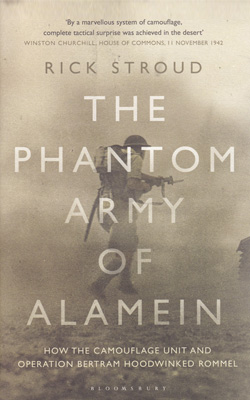Book Reviews

The Phantom Army of Alamein
by Rick Stroud
London: Bloomsbury Publishing, 2012
275 pages, $30.00
ISBN: 978-1-1088-2910-3
For more information on accessing this file, please visit our help page.
Reviewed by Debbie Miller
If some one were to ask you your opinion with respect to Operation Bertram, would you even know what operation they were talking about? I doubt that anyone but a diehard historian or a lover of the art of camouflage would know.
This book is a well written and annotated work dealing with the ‘marriage’ of two very unlikely themes – the artistry of the theatre, overlaid on the background of war, in particular, the North African Campaign of the Second World War, and the events leading up to the Second Battle of El Alamein.
The year was 1940, and Major Geoffrey Barkas had cobbled together a group of theatre designers, film makers, sculptors, model-makers, artists, and set painters who were to become the nucleus of the newly formed Camouflage Unit. The Phantom Army of Alamein tells, for the first time, the full story of how some of Britain’s most creative men put down their brushes, pencils, and cameras to join the rest of the world in the fight against the Nazis, and how they played a vital role in the winning of the war. The mandate of this unit was to support the British 8th Army by using a combination of concealment and embellishment, created with whatever came to hand, in an area and time when resources were very scarce. For example, early in the unit’s infancy, during the siege of Tobruk, they made a vital desalination plant appear to have been destroyed by German bombers. This was the beginning of the utilization of their storytelling skills to intricately weave webs of intrigue and deception; to make things appear that were not really there, and to make things disappear, all in an attempt to deceive the enemy and to give the Allies some advantages. Imagine having a film set the size of the Western Desert, flat and almost featureless, ‘bookended’ by the Mediterranean Sea and the Qattara Depression, upon which to create your illusions. The unit’s primary 1942 project became a crucial battlefield weapon for General Bernard Montgomery, when he ordered them to come up with a scheme to cloak and conceal all the preparations underway for the Second Battle of Alamein.
Operation Bertram at El Alamein was the largest visual deception campaign. It was a monumental misdirection in history, and it is the core of this tale. So, what did these soldier-artist-modellers-camouflagers actually do? How did they ‘hoodwink’ the German Desert Fox, aka Erwin Rommel? The answers constitute the best moments in the book. In general, I believe it would be fair to say that they used two approaches in their work. First, they made key weaponry disappear—not by vanishing, but by disguising it as something else, as a less threatening, innocuous entity. Tanks were made to look like trucks. Field artillery was concealed in other phony forms. And food, fuel, and other supplies were covered up and stacked to look like harmless transport vehicles. Second, at other times, for other purposes, they did exactly the opposite. Making clever use of the simplest materials, they constructed trompe l’oeil dummies (tanks, artillery, support vehicles) to create an illusory build-up, to ‘reveal’ things that were never there – optical illusions. As a result, they made the enemy think that Allied forces were being amassed at times and places that differed critically from the real situation. The Second Battle of El Alamein, in which these methods were employed, was the war’s first substantial land victory for the Allies. In part, Rommel had been hoodwinked by an army made of nothing but string, straw, and bits of wood.
The epic nature of the deception tactics utilized in Operation Bertram, and its role in the Battle of El Alamein, is beautifully told by Rick Stroud. The British, some like to tell you, are not inventive and ‘don’t do stuff.’ This beautifully told story outstrips the standard of many Second World War books I have perused recently, and it constitutes the right blend of unusual subject and solid research, mixed with plain good old fashioned intelligent writing. Stroud describes the colour and the chaos of war in the desert as our heroes wander in and out of the war zone in a succession of battered vehicles. They build amazing things out bits of junk, just like in an episode of MacGyver – these guys were geniuses. Their spirit of improvisation and artistry was immense, and the stakes were enormously high. Having to do all this while battle raged and armies swung to and fro across the desert must have constituted a nightmare.
Exulting in El Alamein, the first great British victory of the Second World War won without the assistance of American forces, Winston Churchill told the House of Commons on 11 November 1942: “By a marvellous system of camouflage, complete tactical surprise was achieved in the desert.”
As I read and reread this book it led me back to an oft-quoted Sun Tzu mantra. The great military philosopher, when referring to wartime deception, advised: “When able to attack, we must seem unable; when using our forces, we must seem inactive; when we are near, we must make the enemy believe that we are far away; when far away, we must make him believe we are near.” I do not know of a better way to describe what these Allied tricksters did than the words embodied in this centuries old quote, as valid in Sun Tzu’s time as it was during the Second World War, and as it is today in the 21st Century…
Lieutenant-Colonel Deborah Miller, OMM, CD, is currently the Senior Staff Officer Strategic Planning at the Canadian Defence Academy in Kingston. She holds a Master of Arts in History, and a Master of Defence Studies from the Canadian Forces College.







